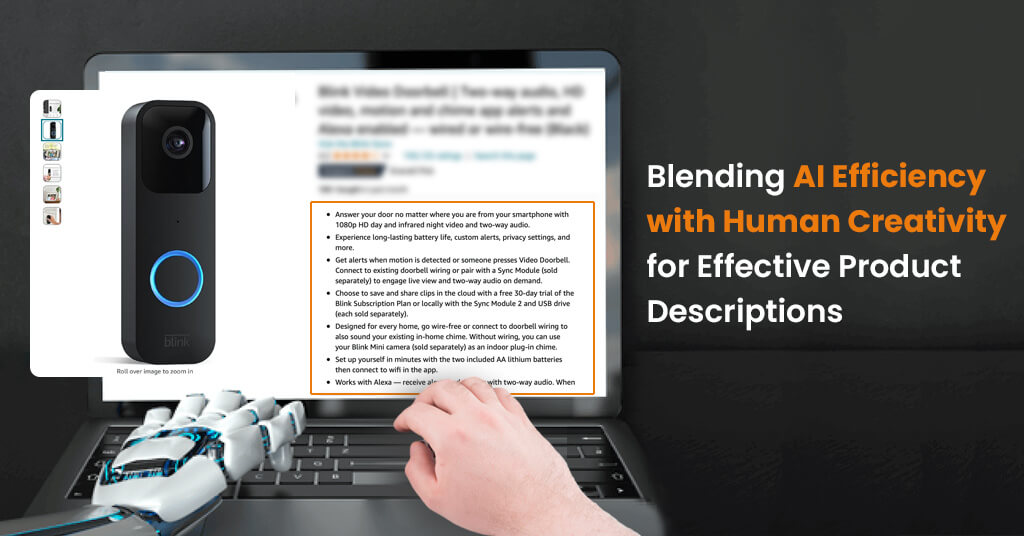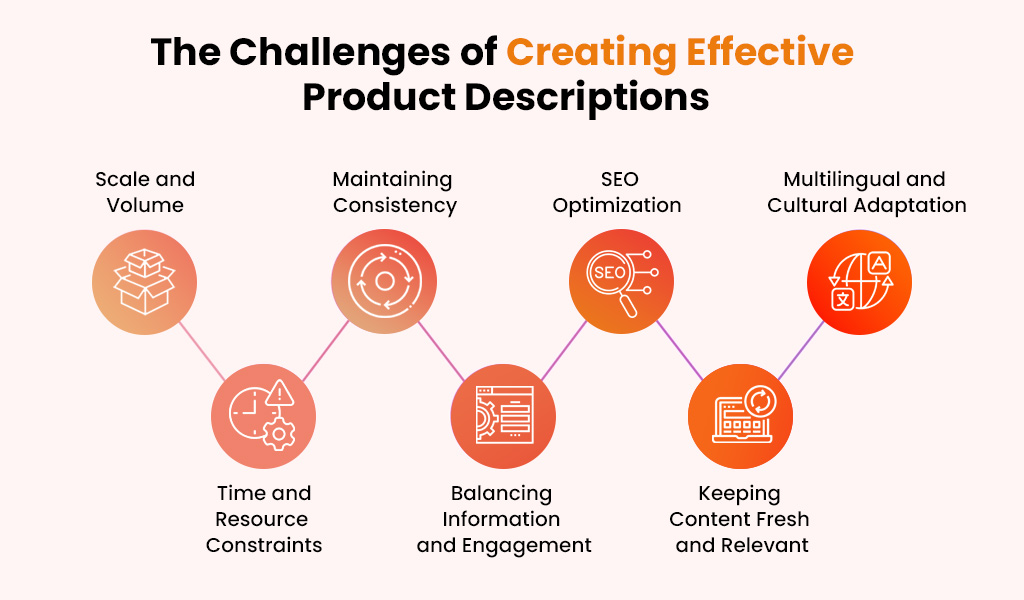
eCommerce is facing a content crisis at an unprecedented scale. As online marketplaces expand at breakneck speed, with giants like Amazon now listing over 350 million products, creating unique and compelling descriptions has become challenging.
Yet, these descriptions are crucial: 85% of surveyed shoppers report that detailed product information and images are key factors influencing their choice of brand or retailer when making a purchase. Without these detailed product descriptions, businesses may lose billions of sales.
But to avoid losing business opportunities, you now have artificial intelligence tools that can generate content at lightning speed. However, as AI’s capabilities in content creation improve, an important question arises: Can AI fully replicate the human touch in crafting product descriptions? Specifically:
- Can it effectively convey brand voice?
- Can it evoke emotion?
- Can it create narratives that engage potential buyers?
The answer, it seems, lies not in choosing between AI and human input but in finding the right balance between the two. This article will explore:
- The challenges of creating effective product descriptions at scale
- The capabilities and limitations of AI in content creation
- How eCommerce businesses are combining AI and human efforts to improve their product content strategies
First, let’s talk about:
The Challenges of Creating Effective Product Descriptions
To understand the value of human-AI collaboration in eCommerce content creation, let’s examine the key hurdles in crafting product descriptions:

1. Scale and Volume
eCommerce platforms often have thousands, if not millions, of products. Creating unique, high-quality descriptions for each item is a monumental task.
2. Time and Resource Constraints
Creating a high-quality description involves thorough research, creativity, and attention to detail. For businesses with large product catalogs, this process can become a substantial commitment, requiring careful planning and resource allocation.
3. Maintaining Consistency
Ensuring a consistent brand voice and quality across all product descriptions is challenging, especially when multiple writers are involved. Inconsistencies can confuse customers and dilute brand identity.
4. Balancing Information and Engagement
Effective product descriptions need to strike a delicate balance between providing all necessary information and maintaining reader engagement. Too much technical detail can bore readers, while too little can leave them uncertain about the product.
5. SEO Optimization
Product descriptions must be optimized for search engines to improve visibility. This requires understanding and implementing SEO best practices, which can be complex and time-consuming.
6. Keeping Content Fresh and Relevant
Products and market trends evolve rapidly. Keeping product descriptions up-to-date with the latest features, benefits, and relevant keywords is an ongoing challenge.
7. Multilingual and Cultural Adaptation
For businesses operating globally, creating product descriptions that resonate across different languages and cultures adds another layer of complexity.
These challenges highlight why product description writing is a significant hurdle for many businesses. However, as we’ll explore in the following sections, integrating AI and human creativity offers a powerful solution to these problems.
AI: The Game-Changer in Product Description Writing
Artificial Intelligence has made significant strides in natural language processing and generation. Salesforce’s Generative AI Snapshot Series, which surveyed more than 1,000 marketers, revealed that 51% are already utilizing generative AI tools.
Here’s how AI-powered product descriptions are changing the eCommerce landscape:
- Speed and Efficiency: AI can generate basic product descriptions in seconds, dramatically reducing the time and resources needed for large-scale content creation.
- SEO Optimization: AI tools can analyze top-ranking product pages to suggest relevant keywords and phrases for optimized descriptions.
- Consistency: Once trained on a brand’s voice and style, AI tools ensure consistent tone and quality across thousands of product descriptions.
- Multilingual Capabilities: AI can quickly translate and localize product descriptions for global markets, facilitating international expansion.
- Data-Driven Insights: AI can analyze customer reviews and search trends to identify key features that should be highlighted in descriptions, aligning content with customer interests.
The Limitations of AI-Only Approach for eCommerce Content
While using AI for eCommerce content offers impressive capabilities, relying solely on AI-generated content has drawbacks:
- Lack of Creativity: AI struggles with original ideas or emotional appeals that resonate with human buyers. For example, it might miss opportunities to use humor or storytelling effectively to sell a product.
- Misinterpretation of Context: AI might miss nuances or cultural references that a human writer would catch. This can lead to inappropriate or tone-deaf content, especially for products marketed across different cultures.
- Potential for Errors: Without human oversight, AI might generate inaccurate or nonsensical content. For instance, it might misinterpret product specifications or create descriptions that don’t match the actual product.
- Over-Optimization for SEO: AI might focus too heavily on including keywords, resulting in awkward or unnatural-sounding descriptions that turn off human readers.
- Ethical and Legal Concerns: AI-generated content might inadvertently include biased language or make claims that could lead to legal issues without proper vetting.
The Human Touch in Product Descriptions: Why we Still Need It
While AI excels at processing data and generating basic content quickly, human writers bring unique qualities that can significantly enhance the effectiveness of product descriptions.
- Emotional Connection
- Humans understand and convey emotions effectively
- They can create descriptions that inspire and excite potential customers
- This emotional appeal in the created content often drives purchasing decisions
E.g.: A human writer can craft a description for a hiking backpack that not only lists its features but also evokes the excitement of adventure and the peace of nature, connecting with the customer’s aspirations and emotions.
- Creativity and Originality
- Humans bring fresh perspectives and innovative ideas
- They can portray the products in a unique way to make them stand out
- This creativity is key in a competitive marketplace
- Understanding Context and Nuance
- Humans grasp cultural contexts, trends, and subtle implications
- This understanding leads to more relevant and relatable descriptions
- It helps avoid potential misunderstandings or inappropriate content
- Brand Voice Consistency
- Humans can maintain and adapt a brand’s unique voice across different products
- They understand the subtle nuances that make a brand distinctive
- This consistency helps in building brand recognition and loyalty
Don’t Settle for Generic—Experience 3X More Sales with Expertly Written Product Descriptions
Best Practices for Human-AI Collaboration in eCommerce Content Creation
By following these practices, businesses can create a synergistic relationship between AI efficiency and human creativity, resulting in more effective and engaging product descriptions.
- Leverage Quality Data
- Train AI models on accurate, up-to-date product information
- Regularly update the AI’s knowledge base to ensure relevance
- Establish Clear Guidelines
- Create comprehensive brand guidelines for tone, style, and messaging
- Ensure both AI systems and human writers adhere to these guidelines
- Implement Continuous Improvement
- Regularly update AI models based on performance metrics
- Incorporate human feedback to refine AI outputs over time
- Optimize Task Distribution
- Use AI for data analysis and basic content generation
- Assign creative and emotionally engaging content to human writers
- Utilize Data-Driven Decision Making
- Employ AI for A/B testing different description versions
- Rely on human expertise to interpret results and make content strategies accordingly
- Maintain Human Oversight
- Ensure all AI-generated content undergoes human review before publication
- Train reviewers to enhance AI-produced descriptions
- Focus on High-Impact Tasks
- Use time saved by AI to allow human writers to develop product narratives to train AI
- Prioritize human effort on aspects that significantly influence customer decisions
Real-World Success Stories
Let’s look at some companies that have been successfully enhancing product descriptions with AI and human input:
- Sephora: The beauty brand combines AI tools with human creativity to craft product descriptions that not only optimize SEO but also maintain a personalized and engaging tone, ensuring the descriptions resonate with their diverse customer base.
- H&M: The fashion retailer uses AI tools to streamline product description writing, especially for global markets. Humans then review and refine the content to ensure it aligns with H&M’s brand voice and accurately reflects the clothing styles.
- eBay: eBay uses AI to assist sellers in generating product listings by suggesting product titles and descriptions. However, human sellers often modify these suggestions to maintain clarity and appeal to specific target audiences.
AI and Human Synergy: The Path Forward
As we move forward, the key to success will be finding the right balance between AI capabilities and human insight. Those who master this integration will gain a significant competitive edge in the digital marketplace.
Key points:
- Enhance, don’t replace: AI should amplify human creativity and decision-making, not substitute it.
- Synergy drives results: The combined power of AI and human insight leads to superior outcomes.
- Competitive edge: Mastering this integration is crucial for staying ahead in your industry.
Ready for content that speaks to your customers?
Tap into our team of expert human copywriters. They’re skilled at crafting tailored product descriptions that resonate with your audience and brand. Contact us to elevate your content strategy.